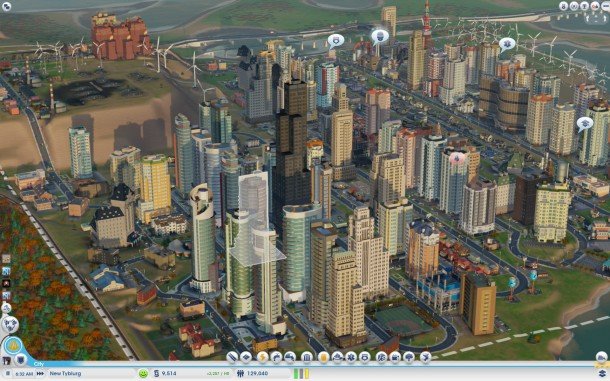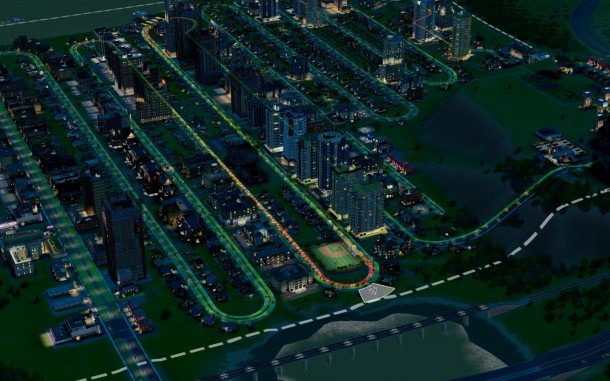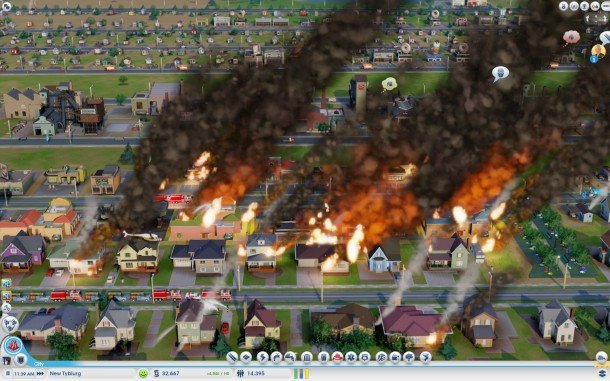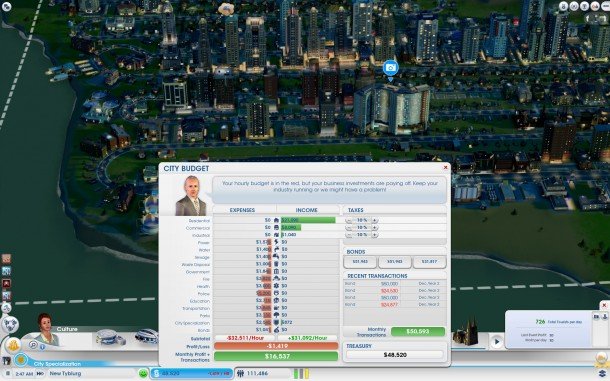SimCity review in progress
Building a one-road metropolis

Welcome to New Tyblurg, population 130,000! A rapidly-growing cultural center, New Tyblurg attracts medium-wealth residents and tourists for luxury living, high-density commercial sectors, and a smidgen of dirty low-tech industry...but don't mind that, the mayor will probably turn the college back on eventually.
There's only one catch: all 130,000 residents have to share one road.
Surprisingly, traffic in New Tyblurg flows well. I had the idea after Rectango failed: my traffic problem there seemed to be caused by cars backing up at too many intersections, so I decided to build a city with no intersections at all. New Tyblurg is one long street which starts at the freeway exit and snakes back and forth until it reaches an end.

In my previous notes I was having trouble understanding SimCity's feedback, but New Tyblurg's conveyor belt design made it easy to observe the flow of Sims and identify the simulation's logic. Here are a few things I like and don't like:
1. When a Sim wants something, it will always go to the closest instance of that thing. Every morning in New Tyblurg, a line of Sims filled each factory with workers, then moved to the next, down the block until they were all staffed. The only exception—I think—may be with player-placed buildings like power plants, which Sims seem to give preference to for obvious reasons. I'm fine with this logic, until...
2. Sims do dumb things. It's impossible for cars to pass each other on one lane roads, so when a firetruck stops to put out a fire, traffic backs up. That makes sense, but when multiple fires are burning, their simple logic becomes a problem. Rather than sending the first truck to the furthest blaze, the second to the second-furthest, and so on, fire trucks always go to the nearest fire whether or not they're needed. In New Tyblurg, that meant that the first truck to leave the station prevented all the other trucks from helping. A smarter AI would favor high-value buildings, or areas with the greatest surrounding fire risk, and I wish that were the case.

3. Demand is a poor indicator of what to zone. Commercial zoning is rarely in demand, but New Tylerburg became very successful with heavy commercial zoning and only light industry later in its life. Instead of looking at demand, I started checking my population panel before each decision. It shows how many unfilled jobs exist in each sector and wealth class, and I zoned residential accordingly to much more success than when I'd based zoning decisions on demand.
The biggest gaming news, reviews and hardware deals
Keep up to date with the most important stories and the best deals, as picked by the PC Gamer team.
SimCity doesn't always give the best advice, but there is a slightly-flawed logic to it, and it's saved by giving us all of its data to study for ourselves. Had it hidden that data, it would be baffling and frustrating.
4. SimCity's fundamental goal is to keep your Sims from leaving . As population increases, services and wealth distribution become more difficult to manage under budget. When Sims aren't happy about that, they leave and income plummets, creating a population fluctuation that seems to max out at around 350,000. It's not a hard limit, but do better and I'll be damn impressed.
This is SimCity's difficulty curve, and how it prevents the creation of cities with higher populations than it can handle. It's logically sound, and without it, SimCity would be about free-form creativity instead of challenging decisions. When a city reaches that high-population state of fluctuation, however, it becomes a dull thing. Population goes up, money comes in, [insert complaint] causes Sims to move out, money is lost, new Sims move in, population goes up, money is earned, and so on, forever and ever.

But of course that happens. If a city can no longer grow, all it can do is fall so it can rise again. It's a good thing much of the joy of SimCity comes from starting a fresh city with a new idea. I'm playing SimCity even when I'm not playing, designing new cities in my head on my commute or when I go to bed, finding new ways to test the simulation, such as with Tyblurg's one-road design.
SimCity's logic isn't quite like a real city's logic, but that doesn't really matter, because I don't play SimCity to become an urban planner. It's an enigma I'm eager to study; a machine I can randomly rewire every night, then turn on and watch as it invariably does something interesting. Its flaws are its limits on the interesting things I can try and it can do, and its strength is the complexity that makes it difficult to identify those limits. (In most cases, that is. The border size is a hard barrier that's instantly noticed.)
That's all for the review in progress! Check back Friday for the final review, which will organize my criticisms of everything—the simulation logic, the UI, the multiplayer, the online-requirement, and so on—into one clear verdict. In the meantime, keep up with our progress in Celebrity SimCity , where we've pooled some of our favorite gaming and internet personalities into a region to see what they build, and how much pollution they can dump into a region.

Tyler grew up in Silicon Valley during the '80s and '90s, playing games like Zork and Arkanoid on early PCs. He was later captivated by Myst, SimCity, Civilization, Command & Conquer, all the shooters they call "boomer shooters" now, and PS1 classic Bushido Blade (that's right: he had Bleem!). Tyler joined PC Gamer in 2011, and today he's focused on the site's news coverage. His hobbies include amateur boxing and adding to his 1,200-plus hours in Rocket League.

